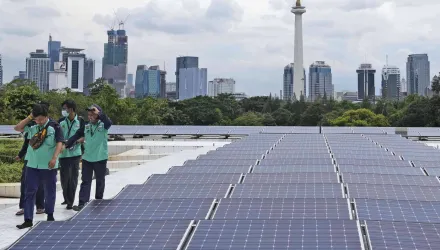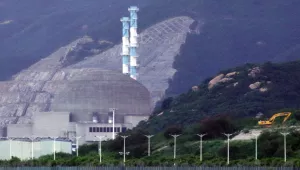1. Introduction
As the largest CO2 emitter in the world, China promised to peak its total carbon emissions around 2030 in its nationally determined contribution (NDC). A national emissions trading system (ETS), launched in December 2017 (NDRC, 2017), has been viewed by scholars and policymakers as a key strategy for China to achieve its emissions mitigation goal (Jotzo et al., 2018; D. Zhang, Karplus, Cassisa, & Zhang, 2014). Since China has accounted for about two thirds of global emissions growth over the past decade (IEA, 2018), controlling its carbon emissions would be a significant contribution to the global effort in combating climate change. However, China's program is likely to face significant challenges due to its large scale and high complexity. While some of these challenges are universal to emissions trading programs around the world, such as emissions accounting, allowance allocation, and market volatility (Schmalensee & Stavins, 2017), the others are unique to China due to the country's particular socioeconomic and political realities. Therefore, some researchers have argued that China's ETS needs to incorporate features that differ from other major ETS programs in the world, such as those in European Union and California, in order to cope with the country's specific conditions (Dong, Ma, & Sun, 2016; Duan & Zhou, 2017; Lo, 2013).
To understand the unique challenges China's ETS is likely to face, we review three major categories of existing studies on China’s ETS: empirical analyses of the performance of China's pilot ETS programs in cities and provinces; modeling analyses of the national program; and political economic analyses of the national program. Based on this literature review, the next section examines the evolution of China's ETS from pilots to the national program. The third section identifies the three most critical challenges, namely the lack of institutional capacities, economic structural transitions, and strong state control in energy sectors. The fourth section presents our policy recommendations. Finally, we offer concluding comments in the fifth section.
2. Evolution of China's ETS from Pilots to National Program
China has chosen an ETS as one of the key approaches to reducing greenhouse gas emissions (Z. Zhang, 2015). Researchers have identified both international and domestic factors that have motivated China to establish ETS. First, as the world's largest CO2 emitter and an emerging geopolitical power, China has begun to shown an increasing willingness to shoulder responsibility for climate change mitigation (Lee & Wang, 2017; Lo, 2015). Since 2013, it made joint commitments for emissions reduction and clean energy development with the United States, the European Union, and several developing countries (Hilton & Kerr, 2017). Advocated as an effective and efficient policy instrument, ETS has been widely studied and implemented in other countries for more than three decades. Subsequently, China has been willing to follow the example set by European Union emissions trading system (EU-ETS) and California, and to learn lessons from their experiences (Schmalensee & Stavins, 2017). Second, China has been facing a bottleneck in economic and social development in recent years, due to excess production capacity in low-end industries, and high environmental costs (Guan, Peters, Weber, & Hubacek, 2009; Lee & Wang, 2017; Qi & Wu, 2013; Z. Zhang, 2010). A national ETS is expected to gradually drive energy-inefficient factories out of business and incentivize the application of more efficient technologies, and to help China to transition from a manufacturing economy to a service economy (Lo, 2013; Springer, Evans, Lin, & Roland-Holst, 2019; H. Zhang, Cao, & Zhang, 2017). And lastly, a national ETS will help change China's coal-dominated energy structure, bringing collateral health benefits through the reduction of severe air pollution in urban areas (Li et al., 2018; Peng, Yang, Wagner, & Mauzerall, 2017; Q. Zhang, He, & Huo, 2012). Coal currently accounts for approximately 70% of China's energy supply and it generates more CO2, SO2, and other pollutants per energy unit than other energy sources (Huang, Hu, Chen, & Zhang, 2017; F. Liu et al., 2015; Z. Zhang, 2010). Model simulations (Dai, Xie, Liu, & Masui, 2018; H. Zhang et al., 2017) show that after implementing the national ETS, the cost of using fossil fuels will increase significantly, and renewable energy sources will be more economically competitive and their market shares will expand. The development of clean technologies and emissions capture and storage will also be incentivized in the long term.
In 2011, China's Twelfth Five-Year Plan (Chapter 21) stated that China should “actively cope with global climate change…and gradually establish carbon emissions trading systems”. In the same year, the National Development and Reform Commission (NDRC) approved a plan to build seven emissions trading pilot programs in five major cities (Beijing, Shanghai, Tianjin, Chongqing, and Shenzhen) and two provinces (Guangdong and Hubei). The seven ETS pilots were initiated in 2013. In principle, the NDRC supervises the design and implementation of all the ETS pilots, but in practice, the NDRC delegates rule-making authority to provincial and municipal governments. Since the purpose of the seven pilot programs is to explore different designing features and accumulate experience for the national program (Dong et al., 2016; Pang & Duan, 2016), the pilot programs have different implementation plans, legislations, and trading rules. The key features of ETS, including cap-setting, coverage of industries, allocation of allowances, MVR (measurable, verifiable, and reportable) rules, and tradable products, therefore vary across pilots (Pang & Duan, 2016) (Table 1).
The ETS pilot programs are accompanied by voluntary Greenhouse Gas (GHG) emissions offsetting programs. As a non- Annex I country in the Kyoto Protocol, China issued guidelines for clean development mechanism (CDM) projects in 2005 and became a major CDM credits provider (Z. Zhang, 2006). In 2012, in preparation for ETS pilots, the NDRC published “Interim Measures on Voluntary GHG Emissions Reduction Trading,” and CDM projects were replaced by the native Chinese Certified Emission Reductions programs (CCER). Trading of CCER is usually restricted to 5–10% of the total emissions in the ETS pilot programs, and some programs have further restrictions on the use of CCER credits, such as the exclusion of CCER obtained from hydropower projects (D. Zhang et al., 2014). Even though the pilot programs created separated markets and allowances are not recognized by each other, the pilot markets are actually indirectly linked by the trading of CCER (Munnings, Morgenstern, Wang, & Liu, 2014).
The seven ETS pilots, covering major emission sectors and enterprises, have played a modest role in reaching local carbon intensity targets (Munnings et al., 2014). The operation of the programs has helped build technical foundations and institutional capacities, and also shaped the first carbon markets and revealed market-driven carbon prices in China. By May 2016, the cumulative market value of traded allowances in the seven pilots reached 1,561.12 million yuan, and their transaction volumes reached 61.25 million ton (Chang, Pei, Zhang, & Wu, 2017). Companies' awareness and capacity in emissions trading was improved. Through a survey conducted in companies participating in the ETS pilots, Yang et al found that companies' attitudes toward the ETS were positively influenced by government policies and estimated economic benefits (Yang, Li, & Zhang, 2016). The pilot programs also have the potential to bring cobenefits in air pollution reduction, according to a modeling study conducted in the Guangdong pilot (Cheng, Dai, Wang, Zhao, & Masui, 2015). But the pilot programs also revealed multiple problems. Liu et al. pointed out that market segmentation, imperfect trading mechanisms, and lack of legal framework seriously affected the effectiveness of the pilot programs (Liu, Chen, Zhao, & Zhao, 2015). Yu and Lo found that regulatory standards and official data on emissions were incomplete and inconsistent, and noncompliance was widespread (Yu &Lo, 2014). Deng et al found that the measuring, reporting, and verification (MRV) and compliance rules were not fully implemented (Deng, Li, Pang, & Duan, 2018).
The lessons from the seven pilot programs, both positive and negative, will be used in the development of the national ETS. Most importantly, the national program will need to reconcile the different rules of the pilots, help the pilot regions transition to the national program, and correct the major problems in the pilots, including insufficient legal foundation, unclear market trading rules, and weak implementation, compliance, and punishments. Launched in December, 2017, the first phase of the national program focused on building a national emissions reporting framework, followed by a “trial run” that initially will cover the power sector, and the later phases will expand the coverage to include other carbon-intensive sectors (Jotzo et al., 2018). However, so far the design details of the national program are still unclear to the public, except for a few general principles, such as the principle that it will cover facilities with annual energy consumption of more than 10,000 ton of coal equivalent, and that the majority of allowances to be given for free based on subsectoral performance standards (Jotzo et al., 2018). Once fully established, the national ETS will have the potential to become a key feature of China's climate governance, and the primary policy instrument of its emission reduction goals (Jotzo et al., 2018; L. Liu, Chen, et al., 2015). Furthermore, if it is properly designed and implemented, it could be the most cost-effective policy option, according to the results of modeling studies conducted by many researchers (Cui, Fan, Zhu, & Bi, 2014; Fan, Wu, Xia, & Liu, 2016; Hübler, Voigt, & Löschel, 2014; Mu, Evans, Wang, & Cai, 2018; K. Wang, Wei, & Huang, 2016). Yet, on the other hand, the success of an ETS program requires the appropriate institutional context at both macro- and microlevels. Well-functioning market mechanisms, long-term policy credibility, and strict monitoring and enforcement are all crucial to the alignment of enterprise interests with the broader public-oriented goal of ETS. In this sense, China is expected to face significant challenges in the development of a national ETS, as will be discussed in the following section.
Wang, Pu, Zhu Liu, Xianchun Tan and Lei Liu. “Key Challenges for China's Carbon Emissions Trading Program.” Wiley Interdisciplinary Reviews: Climate Change, May 2019








